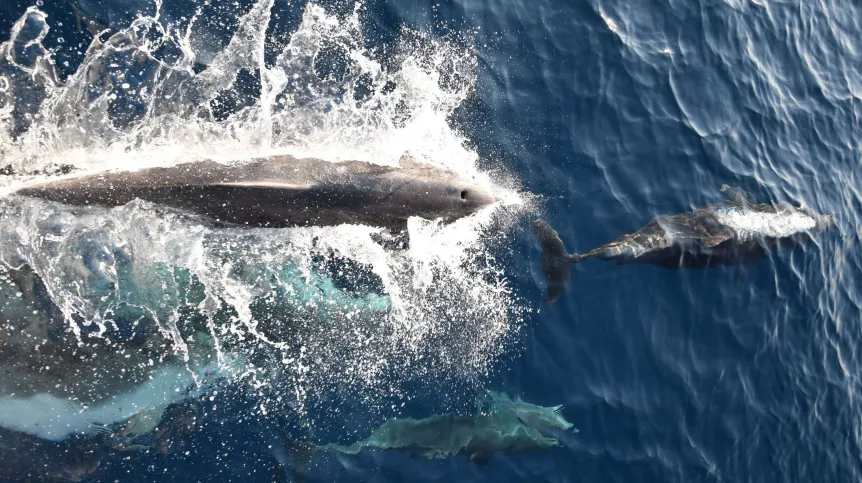
Dolphins and porpoises from the Black Sea are among the victims of the war in Ukraine, and as a result could face extinction, say researchers.
Publishing their findings in the International journal Biology Letters, scientists from the University of Rzeszów and from Ukraine said that between 37,000 and 48,000 have died in just three months as a result of Russian warships.
The first reports of dead dolphins appeared right after the outbreak of war in Ukraine.
Dr. Ewa Węgrzyn from the University of Rzeszów said: “One of the co-authors of our study, Ivan Rusev, lives and conducts research on the Black Sea coast, in the Tuzlivskie Limany National Park.
“After the outbreak of the war, he noticed an increase in the number of dead dolphins washed ashore. He also received similar reports from other countries surrounding the Black Sea.”
These were very disturbing reports as all three species of cetaceans inhabiting the Black Sea: the harbour porpoise, the short-beaked common dolphin and the common bottlenose dolphin, are all listed on the IUCN Red List of Threatened species.
This is why scientists decided to carry out research to see how Russian aggression against Ukraine affected cetaceans living in the Black Sea, and what was the scale of the threat.
Beginning in May 2022 and continuing for three months. Scientists were looking for a method that would enable them to collect a large amount of data from a huge area, a particularly difficult task in times of war. They decided to carry out the project in two ways and at the end compare the results.
They collected data in a traditional way, by conducting research on a section of the Black Sea coast, in the Tuzlivskie Limany Park. At the same time, they collected information published on social media from all countries around the Black Sea basin. The latter approach is a modification of citizen science.
Dr. Węgrzyn said: “We assumed that for many people finding a dolphin washed ashore would be a deeply emotional event, so the likelihood that eyewitnesses would share information or photos on social media platforms seemed really high.”
Using information published on social media by residents of Ukraine, Romania, Bulgaria, Turkey and Russia, scientists collected data on about 2,500 bodies of dolphins and porpoises found on the Black Sea coast.
Because only 6-8 percent dead of cetaceans are washed ashore (the rest sink to the bottom), 2,500 cetaceans found on beaches translate into an approximate mortality of between 37,500 and 48,000 individuals during just three months of war.
Professor Konrad Leniowski, co-author of the study, said: “This is a huge number, one-sixth to one-fifth of the entire pre-war population of cetaceans in the Black Sea, numbering about 253,000 individuals. In the long perspective of military operations in the Black Sea, the cetaceans may face extinction.”
The results of research conducted with traditional scientific methods in Tuzlivskie Limany Park were consistent with the results obtained by analysing information from social media. In both cases, the researchers determined the number of dead cetaceans per kilometre of coastline, yielding values of 0.5 and 0.7, respectively. This means that the information obtained from social media accurately reflected the mortality of dolphins and porpoises due to the war.
The scientists also compared the mortality of cetaceans in the Black Sea during the war to data from before. It turned out that during the war, the death rate increased 8.8 to 14.3 times depending on the location.
Dolphins and porpoises lose their lives during naval military operations for several reasons. Many of them die as a result of injuries directly caused by explosions in the Black Sea. The source of numerous explosions were mines, the naval battle of Snake Island, as well as Russian shelling of the port of Odessa.
Other dolphins have died of decompression sickness because explosions can cause them to rise to the surface too rapidly. Decompression sickness leaves marks on the body in the form of skin and eyeball lesions.
Sonars used by the navy to detect submarines, target torpedoes and scan the seabed are also a serious threat. The waves emitted by a sonar can influence the behaviour of cetaceans up to 90 nautical miles away, suggesting that military operations during the war do not leave many undisturbed places for dolphins and porpoises that live in the Black Sea.
Sonars emit acoustic waves that damage the part of the dolphin's brain called the melon, which is responsible for navigation and hunting.
Dr. Węgrzyn said: “When it is damaged, dolphins lose the ability to navigate and hunt. As a result, they die due to starvation and hypothermia. Energy loss above 40 percent is a lethal threat to dolphins and can result from only ten days of fasting.”
Some dolphins and porpoises found on the beaches were still alive, but so badly injured that they could not be helped.
The research concluded with a publication entitled 'The use of social media in assessing the impact of war on cetaceans'. The authors are zoologists from the University of Rzeszów: Dr. Ewa Wegrzyn, Dr. Konrad Leniowski, Dr. Natalia Tańska and scientists from Ukraine: Dr. Ivan Rusev, Iryna Miedviedieva and Dr. Aleksander Kagalo.
PAP - Science in Poland, Agnieszka Lipska
al/ mark/ kap/
tr. RL













